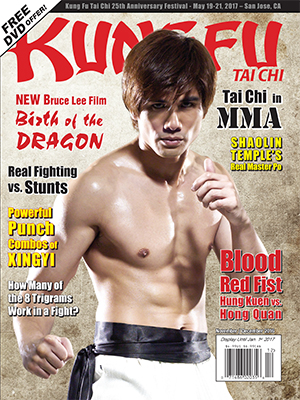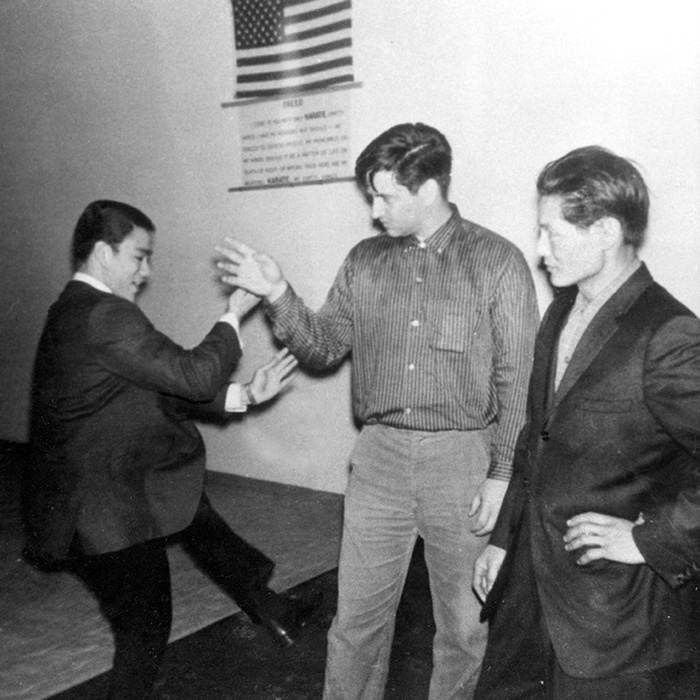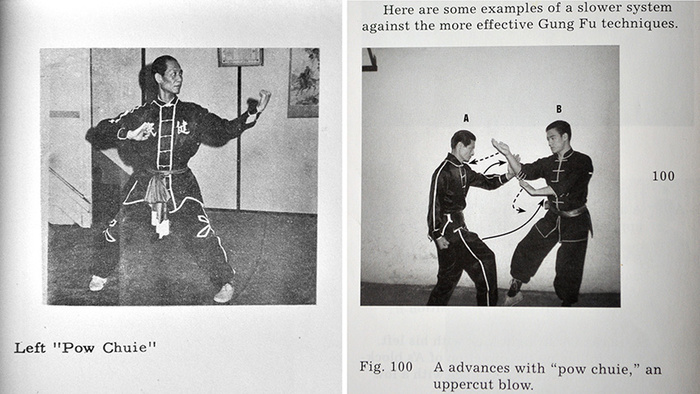The Dissident
By the start of 1964, Bruce began to double-down on his earlier criticism of “ineffective” styles and techniques, and began given lecture-heavy demonstrations featuring stinging rebukes towards “dry-land swimmers” practicing the “classical mess.” By contrast, he referred to his own approach as “scientific street fighting,” and made a habit of demonstrating other styles and then methodically explaining why they wouldn’t work in a street fight. One of the styles he liked to perform and then dismiss was Northern Shaolin, and he began to air these viewpoints to some very large and qualified audiences.
At Ed Parker’s inaugural Long Beach Tournament in August, Bruce delivered a scathing lecture that disparaged many existing practices, including such common techniques as the horse stance. “He just got up there and started trashing people,” explains Barney Scollan, an 18-year-old competitor that day. Although Bruce’s showing at Long Beach is often painted in glossy terms, many of those in attendance corroborate the polarizing nature of his demonstration, in which half the crowd perceived him as brash and condescending. As longtime karate teacher Clarence Lee remembers it: ““Guys were practically lining up to fight Bruce Lee after his performance at Long Beach.”

In late summer of '64, Bruce accompanied Hong Kong starlet Diana Chang Chung-wen ("the Mandarin Marilyn Monroe") on a promotional tour of the U.S. west coast in support of her latest film. This brought them to the Sun Sing Theater, in the heart of San Francisco's Chinatown where Bruce's demonstration and critical lecture would infuriate the neighborhood's martial arts practitioners. (Photo courtesy of UC Berkeley)
A few weeks later before a capacity crowd at the Sun Sing Theater in the heart of San Francisco’s Chinatown, Bruce gave a similar demonstration, and even went as far as to criticize the likes of Lau Bun and TY Wong by declaring “these old tigers have no teeth.” It was a considerable insult coming from a young martial artist towards two highly-respected members of the community.
At this point, a confrontation wasn’t surprising…it was logically inevitable, especially when considering that Bruce had been challenged for similar reasons in Seattle a few years earlier on far less provocation. That fight was also predicated on the content of Bruce’s demonstrations at the time, when local karate practitioner Yoichi Nakachi took issue with Bruce’s martial arts worldview and loudly issued a challenge. Yoichi pursued him for weeks. When the two finally fought, Bruce obliterated Yoichi with a rapid series of perfectly places punches and a knockout kick in an 11-second fight that left him unconscious with a fractured skull. Oddly enough, the entire affair tends to get shrugged off as meaningless; when really, it should be seen as a case study.

Bruce Lee with student Barney Scollan in east Oakland, where Bruce eventually relocated his school into James Lee's garage. An earlier formal location on Broadway Avenue—where the Wong Jack Man fight took place—proved to be short-lived. (Photo courtesy of Barney Scollan)
“Made to Fight”
One of the most enduring questions that still remains difficult to answer, is—“Why Wong Jack Man?” Of all the practitioners in Chinatown to step forward to issue a challenge, why was it a recent transplant that had never even met Bruce Lee before?
There are two main theories on this. The first is that because Wong Jack Man was poised to open his own martial arts school in Chinatown, he stepped forward in an opportunistic moment to generate some publicity. Local tai chi practitioner David Chin asserts that Wong said as much when he signed a challenge note to be delivered to Bruce. Yet a more popular theory professed by many local sources from that era is that Wong Jack Man was duped into fighting Bruce, essentially the new kid on the scene goaded into a schoolyard brawl without grasping the stakes.
But who were those five people that drove over to Oakland with Wong Jack Man? In the front seat with Wong were David Chin and Chan “Bald Head” Keung, two martial artists that frequented the Ghee Yau Seah (The Soft Arts Academy), a sort of tai chi social club that had been established within Chinatown in the early 1930s. In the back seat, were a trio of hanger-on troublemaker types, with no strong connections to the neighborhood’s martial arts scene: Ronald “Ya Ya” Wu (whose nickname reflected his constantly yammering mouth), Martin Wong, and Raymond Fong. As Wong Jack Man would later put it, this group was “only there to see the hubbub.”
No one in the car was a student of TY Wong’s Kin Mon or Lau Bun’s Hung Sing, but tied instead to the Ghee Yau Seah. In fact, Lau Bun’s senior student Sam Louie remembers his school mates abiding by Lau Bun’s code of conduct and admonishing this crew as they riled themselves up that day prior to the fight: “We said, ‘It has nothing to do with Hung Sing.’ And we explained to them, ‘You go into someone’s studio…it’s no good. Whether you win or lose…it’s no good.’”
In Oakland, Bruce would only have two witnesses: his recent bride Linda Lee (who was 8 months pregnant at the time) and his close colleague James Lee (who had a loaded handgun nearby in case things spiraled out of control). This made for a total of nine people in the room, only three of whom are alive today. With a couple of very rare exceptions, Wong Jack Man has stayed perennially quiet on the matter. Linda Lee and David Chin, who were on opposing sides of the conflict, give a generally similar account: the fight was fast and furious, spilling wildly around the room. The exchange was crude, and far from cinematic. After landing an opening blow on Wong’s temple, Bruce struggled to decisively put away his evasive opponent like he had in Seattle a few years earlier, and quickly found himself heavily winded by the encounter.
Eventually Bruce’s relentless advance caused Wong to stumble over a small step, into an untenable position on the floor where Bruce hollered “Do you yield?” in Cantonese over and over while pummeling him repeatedly. Having lost his footing, Wong had no choice but to concede. “From there, he said he gives up and we stopped the fight,” recalls David Chin. “The whole thing lasted…not more than seven minutes.”
As with any good schoolyard fight, the exaggeration soon took on epic proportions. Storylines of Bruce slamming Wong’s head through a wall, or of Wong having Bruce in a headlock and ready to knock him out when the cops arrived, are just a couple among many. Perhaps the most absurd of the hyperbole, which is now a regular storyline in the press surrounding the upcoming release of Birth of the Dragon, is that the fight lasted for 20 minutes, a notion which is not only wholly inconsistent to the accounts of all proven eyewitnesses, but contrary to all basic sense for the nature of a street fight.

A rare image of Bruce Lee demonstrating techniques the night before the first Long Beach Tournament, in the summer of 1964. (Photo courtesy of Barney Scollan)
In the fight’s aftermath a war of words took place in local Chinese newspapers, in which both Bruce and Wong denied starting or losing the fight. In time, the urban mythology surrounding the incident would cite that Wong issued a call for a rematch in his article, though the exact wording suggests otherwise: “[Wong] says that in the future he will not argue his case again in the newspaper, and if he is made to fight again, he will instead hold a public exhibition so that everyone can see with their own eyes.” Although not an exact quote from Wong, the wording is curious—made to fight—and hints at the idea that Wong was indeed manipulated into the affair.
What is generally agreed upon is that Bruce Lee’s messy victory—light years from his precise 11-second win over Yoichi in Seattle—was a catalyst for him to finally overhaul his approach. For a martial artist who all year long had been so loudly professing the effectiveness of his technique against the inferiority of others, Bruce found the Wong Jack Man fight to be a sober reality check, in which both his technique and his conditioning came up very short of his expectations.
The timing was right for Bruce to begin tangibly forming his new system, Jeet Kune Do. He had already been synthesizing many of the influences that he had been exposed to in recent years—from James Lee’s street-fighter sensibility to Wally’s Jay’s propensity for innovation—to form an integrated system personalized to the individual. In creating Jeet Kune Do, Bruce incorporated elements of Wing Chun, fencing, and American boxing into a minimalist-based approach with a philosophical orientation.
Yet among the more egregious historical liberties that the new film appears to be taking, Wong Jack Man’s character will literally explain core Jeet Kune Do principles to him, as if it wasn’t the fight itself that impacted Bruce, but Wong’s personal martial arts wisdom.






 Reply With Quote
Reply With Quote.jpg)



























